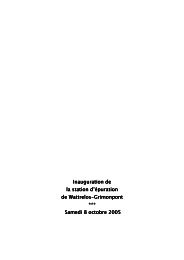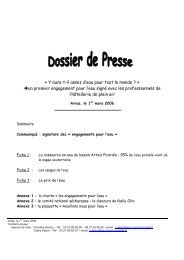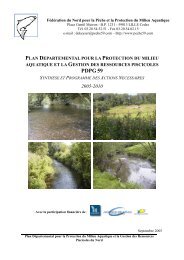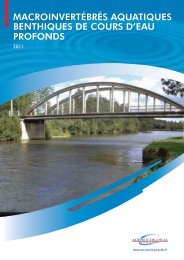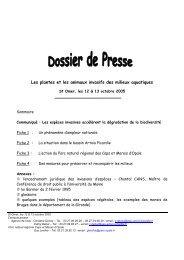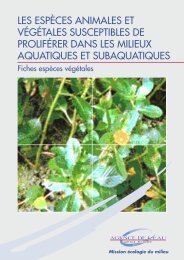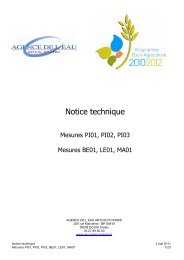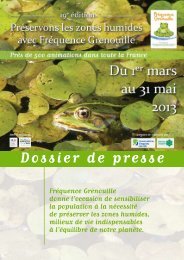masse d'eau souterraine n° 1010 - Agence de l'eau Artois Picardie
masse d'eau souterraine n° 1010 - Agence de l'eau Artois Picardie
masse d'eau souterraine n° 1010 - Agence de l'eau Artois Picardie
You also want an ePaper? Increase the reach of your titles
YUMPU automatically turns print PDFs into web optimized ePapers that Google loves.
FICHE DE CARACTERISATION INITIALE MES <strong>1010</strong> 21/06/042 / 10
FICHE DE CARACTERISATION INITIALE MES <strong>1010</strong> 21/06/043 / 102 – DESCRIPTION DE LA MASSE D’EAU SOUTERRAINE -CARACTERISTIQUES INTRINSEQUES2.1 – DESCRIPTION DU SOUS-SOL2.1.1 – DESCRIPTION DE LA ZONE SATUREE2.1.1.1 – LIMITES GEOGRAPHIQUES DE LA MASSE D’EAUCette <strong>masse</strong> <strong>d'eau</strong> s'étend sous la région <strong>de</strong> Cambrai. Elle est limitée du nord à l'est par l'interfluve Selle-Ecaillon,au sud-est par la crête piézométrique la séparant du bassin <strong>de</strong> la Sambre, au sud-ouest par la crête piézométrique laséparant du bassin <strong>de</strong> la Somme et à l'ouest par la crête piézométrique la séparant du bassin versant amont <strong>de</strong> laSensée.Elle comprend la partie amont du bassin versant <strong>de</strong> l'Escaut au <strong>de</strong>ssus <strong>de</strong> Denain.2.1.1.2 - CARACTERISTIQUES GEOLOGIQUES DES RESERVOIRS SOUTERRAINS2.1.1.3 - CARACTERISTIQUES GEOMETRIQUES DES LIMITES DE LA MASSE D’EAU2.1.2 – CARACTERISTIQUES HYDRODYNAMIQUES ET DESCRIPTION DESECOULEMENTS2.1.2.1 –RECHARGES NATURELLES, AIRES D’ALIMENTATION ET EXUTOIRES• Recharge naturelle• Aire d’alimentation• Exutoires2.1.2.2 – ETAT(S) HYDRAULIQUE(S) ET TYPE(S) D’ECOULEMENT(S)• Etat(s) hydraulique(s) <strong>de</strong> la <strong>masse</strong> d’eau• Type(s) d’écoulementType d’écoulementprépondérantPoreux Fissuré Karstique Mixte2.1.2.3 – LA PIEZOMETRIECarte piézométrique : figure 2
FICHE DE CARACTERISATION INITIALE MES <strong>1010</strong> 21/06/044 / 102.1.2.4 – PARAMETRES HYDRODYNAMIQUES ET ESTIMATION DES VITESSES DEPROPAGATION DES POLLUANTS2.1.3 – DESCRIPTION DE LA ZONE NON-SATUREE DU SOUS-SOL• Epaisseur <strong>de</strong> la zone non saturéeEpaisseur <strong>de</strong> la zone saturée (m)Nombre<strong>de</strong> points<strong>de</strong> mesurePoints à une altitu<strong>de</strong>< 60 m (vallées,points bas)Points à une altitu<strong>de</strong>> 60 m (plateaux)e < 5faible5 < e < 20moyenne20 < e < 50gran<strong>de</strong>e > 50très gran<strong>de</strong>0 1 1 01 4 6 1Tableau établi à partir <strong>de</strong>s données piézométriques <strong>de</strong> l’année 2000 issues du réseau patrimonial <strong>de</strong> l’<strong>Agence</strong>.• Perméabilité <strong>de</strong> la zone non saturéePerméabilité <strong>de</strong> la zone non saturée (valeur du coefficient <strong>de</strong> perméabilité)Peu perméable Semi-perméable Perméable< 10 -8 m/s Entre 10 -6 et 10 -8 m/s Entre 10 -2 et 10 -6 m/s2.2 – DESCRIPTION DU SOL2.3 – CONNECTIONS AVEC LES COURS D’EAU ET LES ZONES HUMIDESType <strong>de</strong> relation / source <strong>de</strong>s donnéesCours d’eauZones humi<strong>de</strong>sAlimentation par la MESPerte vers la MESNatura 2000Autres sourcesd’informationNom du cours d’eau ou zone humi<strong>de</strong>Relation avérée Relation supposée2.4 – ETAT DES CONNAISSANCESCommentaire libre
FICHE DE CARACTERISATION INITIALE MES <strong>1010</strong> 21/06/045 / 10
FICHE DE CARACTERISATION INITIALE MES <strong>1010</strong> 21/06/046 / 10
FICHE DE CARACTERISATION INITIALE MES <strong>1010</strong> 21/06/047 / 103 – PRESSIONS3.1 – OCCUPATION GENERALE DU SOLOccupation générale du sol (en % <strong>de</strong> la surface totale)Situation actuelle (d’après Corine Land Cover 1989-94)Date \ Zone Urbaine Agricole Forestière Industrielle AutreCarte d’occupation du sol (A4 établi d’après Corine Land Cover 1994)3.2 – DETAIL DE L’OCCUPATION AGRICOLE DU SOLDétail <strong>de</strong> l’occupation agricole du sol et évolutions tendancielles <strong>de</strong> l’occupation du sol et <strong>de</strong>s pratiquesculturales (irrigation, drainage agricole, etc.) d’après le RGA 2000Commentaire libre 213.3 – ELEVAGECommentaire libre 223.4 – EVALUATION DES SURPLUS AGRICOLESCommentaire libre 233.5 – POLLUTIONS PONCTUELLES AVEREESCommentaire libre 243.6 – CAPTAGESPression <strong>de</strong> prélèvement : situation actuelle et évolution tendancielle <strong>de</strong>s captagesAnnée <strong>de</strong> référence : 2000Prélèvements \ Types d’utilisation AEP Irrigation Industrie TOTALEaux <strong>souterraine</strong>s seules (mes spécifiée) m 3 /an%1702110486,82863051,5230675011,819614159100Nombre <strong>de</strong> points <strong>de</strong> captage 97 21 39 157BaisseXEvolution temporelle <strong>de</strong>s Stableprélèvements d’eau <strong>souterraine</strong> Hausse X XX
FICHE DE CARACTERISATION INITIALE MES <strong>1010</strong> 21/06/048 / 103.7 – RECHARGE ARTIFICIELLEPratique <strong>de</strong> la recharge artificielle <strong>de</strong> l’aquifère : non4 – ETAT DES MILIEUX ET EVALUATION DU RISQUE4.1 – LES RESEAUX DE SURVEILLANCE QUANTITATIF ET CHIMIQUECarte <strong>de</strong>s réseaux <strong>de</strong> mesure : figure 1Nombre <strong>de</strong> points et fréquence <strong>de</strong>s mesuresTypes <strong>de</strong>s réseaux <strong>de</strong>QuantitatifQualitatifsurveillanceNombre Fréquence Nombre Fréquence1/semaine (libre)Réseau patrimonial 131/mois (captif)1/an192/jour (stationsautomatisées)Réseau complémentaire 1011/anRéseau sanitaire 142selon décret 2001-12204.2 – FOND HYDROCHIMIQUE NATURELLes eaux <strong>souterraine</strong>s sont <strong>de</strong> type bicabonaté calcique, elles ne présentent pas, à l'état naturel, <strong>de</strong> teneurschimiques anormales : On ne trouve en effet aucun produit phytosanitaire ni <strong>de</strong> métaux lourds, les concentrationsen nitrates n'excè<strong>de</strong>nt jamais 10 mg/l.
FICHE DE CARACTERISATION INITIALE MES <strong>1010</strong> 21/06/049 / 104.3 – CARACTERISTIQUES QUANTITATIVES ET HYDROCHIMIQUES,SITUATION ACTUELLE, EVOLUTION TENDANCIELLE ET EVALUATIONDU RISQUEQUANTITATIFCHIMIQUENombre<strong>de</strong> points<strong>de</strong> mesure13Nature dupolluantETAT DE LA MASSE D’EAUCommentaireétat<strong>masse</strong> <strong>d'eau</strong>en équilibreNombre<strong>de</strong> points<strong>de</strong>mesurenitrates 91pestici<strong>de</strong>s 22Solvantschlorés16Etat initial en 2000Degré <strong>de</strong>sollicitation9%Commentairesur 91 points, 61,5 %sont à problème dont :- 19,8 % > 40 mg/l-41,8 % tendance à lahaussesur 22 points, 9 % sontà problèmesur 16 points, 12,5 %sont à problèmeCommentairesollicitationsollicitation trèsfaibleProblèmequalitatifsur plus<strong>de</strong> 20 %<strong>de</strong>s pointsouinonnonEVALUATION DU RISQUETendance <strong>de</strong>s pressions <strong>de</strong>captage à l’horizon 2015RisqueTendanceCommentairegénéralestabilitéstabilité due à lacompensation <strong>de</strong>l'augmentation <strong>de</strong>sprélèvements AEPpar la diminution<strong>de</strong>s prélèvementsindustrielsConditions en pressionvulnérabilitésur la MEla répartition <strong>de</strong>s points sur la<strong>masse</strong> <strong>d'eau</strong> représente plus <strong>de</strong>80 % <strong>de</strong> la surfaceplus <strong>de</strong> 20 % <strong>de</strong> la surface estsoumise à une forte pression enpestici<strong>de</strong>s (diffuse) et une fortevulnérabilitémoins <strong>de</strong> 20 % <strong>de</strong> la surface <strong>de</strong>la <strong>masse</strong> <strong>d'eau</strong> présente lesmêmes conditions en pression -vulnérabilité pour les solvantschloréspas <strong>de</strong>risqueRisquepour lepolluantà risqueà risquepas <strong>de</strong>risqueEn ce qui concerne les autres polluants (chlorures, sulfates, ammonium, métaux), aucun problème n'est à signaler, iln'existe aucune concentration anormale décelée sur la <strong>masse</strong> <strong>d'eau</strong>.
FICHE DE CARACTERISATION INITIALE MES <strong>1010</strong> 21/06/0410 / 104.4 –SYNTHESE D’ANALYSE DU RISQUEETAT RISQUE Commentaire synthétiqueQUANTITATIF pas <strong>de</strong> risquela <strong>masse</strong> <strong>d'eau</strong> est en équilibre et les prélèvements restent stablesCHIMIQUEà risqueLa <strong>masse</strong> <strong>d'eau</strong> présente un risque pour au moins 2 polluants, elle est doncglobalement à risque.Pour les nitrates risque lié à une pollution avérée.Pour les phytosanitaires risque lié à une pression significative et une fortevulnérabilité.Tableau récapitulatif <strong>de</strong> l’appréciation du risque <strong>de</strong> ne pas atteindre le bon état en 20154.5 –NIVEAU DES CONNAISSANCES SUR L’ETAT DES EAUXSOUTERRAINES ET APPRECIATION DU NIVEAU DE CONFIANCE DEL’EVALUATION DU RISQUELes niveaux <strong>de</strong> surveillance quantitatif et qualitatif <strong>de</strong>s eaux <strong>souterraine</strong>s ainsi que l'évaluation <strong>de</strong>s problèmes sontcorrects. Le nombre et la répartition <strong>de</strong>s points <strong>de</strong>s différents réseaux <strong>de</strong> mesure permettent une bonnereprésentativité <strong>de</strong> l'ensemble <strong>de</strong> la <strong>masse</strong> <strong>d'eau</strong>.La notion <strong>de</strong> vulnérabilité <strong>de</strong> la <strong>masse</strong> <strong>d'eau</strong> a été établie à dire d'expert et selon une hypothèse maximaliste.En terme <strong>de</strong> pression, la pollution par les nitrates et les phytosanitaires étant diffuse (origine agricole et urbaine),elle est significative sur l'ensemble <strong>de</strong> la <strong>masse</strong> <strong>d'eau</strong>. Par contre, pour les solvants chlorés, la pollution est plutôtponctuelle et donc pas généralisée à toute la <strong>masse</strong> <strong>d'eau</strong>.Compte tenu <strong>de</strong>s paramètres pris en compte et <strong>de</strong>s données disponibles, on peu donc dire que le niveau <strong>de</strong>confiance d'évaluation du risque est bon.Par la suite, afin d'affiner l'évaluation <strong>de</strong> risque, il faudra voir à nuancer la notion <strong>de</strong> vulnérabilité notamment enfonction <strong>de</strong> la nature et <strong>de</strong> l'épaisseur <strong>de</strong> recouvrement qui sont variables sur la <strong>masse</strong> <strong>d'eau</strong>. Une zonation parsecteur plus ou moins à risque sera à créer avec pour chacune <strong>de</strong> ces zones l'établissement d'un programme <strong>de</strong>mesures à prendre adapté.



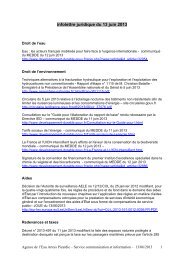
![RPC [Mode de compatibilité] - Agence de l'eau Artois Picardie](https://img.yumpu.com/51247768/1/184x260/rpc-mode-de-compatibilitac-agence-de-leau-artois-picardie.jpg?quality=85)

